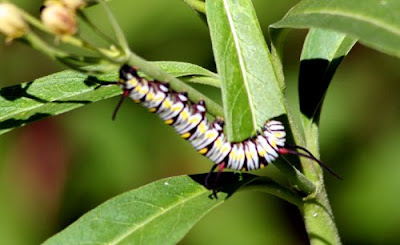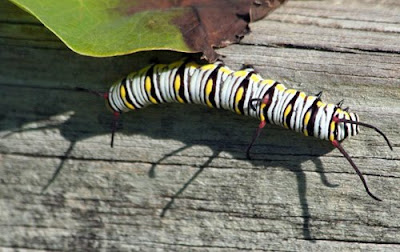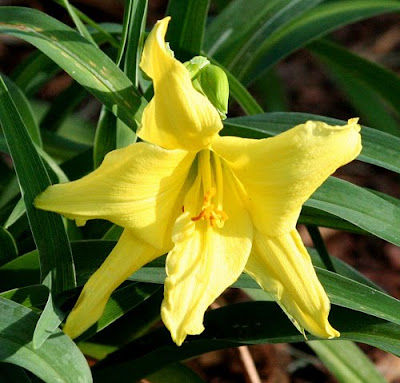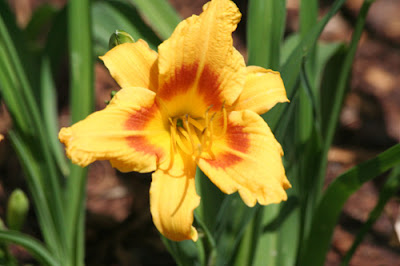
Here's what I mean - a view of part of my backyard with its crispy brown grass. (Yes, I know the bottle tree is crooked. It's a combination of no moisture and strong winds. I'll get around to straightening it one of these days.)

Maybe it was the drought that made the 'Red Lion' amaryllis so late to bloom this year.

The 'Sunset Yellow' hibiscus has been in bloom for a while now. Its leaves keep turning sunset yellow, too, and falling off, but it just keeps putting on these blooms.

'Radazz' Knockout roses put up a bouquet of blooms at all stages of development. (Those ugly brown tendrils are from the nearby coral honesuckle - another thing I'll get around to pruning someday.)

In the late evening and until the early morning hours, the old-fashioned 4 o'clocks send forth their variegated blooms. They are visited by hummingbirds in daylight hours and moths at night.

Did you ever wonder if native bees will actually use one of these manmade tube nests? The answer is, "Yes, they will!" The mason bees have been very active around this nest in the old apple tree this spring. I find it interesting that they seem to utilize the outer tubes first. I'm sure there is a scientific explanation for that. I just don't happen to know what it is.

'Pink Delight' buddleia has begun its bloom cycle and has been found by this tiny Gray Hairstreak butterfly and a native bee, almost hidden among the florets.

Most of the tropical milkweed plants are in full bloom now. These were passalongs (the best kind of plants!) from my fellow blogger Butterhummer last year.

I love salvias and I grow several all around my garden. This one has an interesting story. It is a tough Texas native Salvia farinacea found by horticulturalist Greg Grant in a cemetery. There were two color variations. This white one was growing on the grave of a woman named Augusta Duelberg and so Greg named it for her - Salvia farinacea 'Augusta Duelberg.'

Next to Augusta's grave was her husband, Henry's, and the salvias growing there were purple. They became Salvia farinacea 'Henry Duelberg.' I grow 'Henry' and 'Augusta' side by side in my garden.

Another tough, drought-tolerant plant is yarrow. This white one was passed along to me by fellow blogger Ursula. It can be invasive, but such pretty, delicate, cooling blossoms are worth a little extra trouble.

And speaking of tough, this is the plant that wrote the book. This is the genuine old tawny orange 'ditch lily.' This is the first bloom of the year from the clump of plants that I dug several years ago from my mother's garden.

This is the time of year when orange starts to become a dominant color in my garden, and they don't come any more "orange" than the canna 'Lucifer.'

The little cigar plant Cuphea joins the orange parade. It has just a few of these tiny cigar-shaped blooms now, but soon it will be covered with them and it will remain covered with them until frost. The hummingbirds love these blossoms.

The little red-orange gerbera raises its head above the variegated artemisia.

The anole sits on a downspout that hasn't had anything significant flowing through it for months. I find that when I water plants now the anoles come out to sip from the leaves.

These horsetail reeds (Equisetum hymale) growing at one end of my little pond are developing these interesting "flowers," except they are not flowers really. The plant reproduces by spores.

Nearby, three of my little goldfishes couldn't care less how horsetail reeds reproduce. They are more interested in how goldfish reproduce.

My ancient 'Caldwell Pink' rose, a Valentine's Day gift from hubby long ago, is now in full bloom. It got a late start this year because I was late in pruning it. (Behind it, you can see still more of my dry brown grass.)

In a bed near the 'Caldwell' another Salvia farinacea, the wonderful 'Indigo spires,' is beginning its long season of blooms.

And on a post of the muscadine trellis, my little furry friend keeps watch over it all. He'll have to wait a long time for those muscadines.
We've almost made it to May and that is when, the climate scientists tell us, the dry La Nina phase of ENSO should begin to wind down and then we may have a better chance for rain. Let us hope it is so.

































